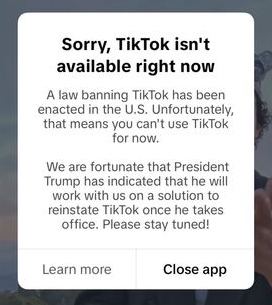TikTok went dark in the United States at 12 a.m. ET on Sunday (January 19), leaving roughly 170 million users wondering if the move will be reversed.
While President-elect Donald Trump said he will “most likely” figure out a way to save the popular app, he didn’t take office soon enough to prevent it from going down. But if TikTok has its way, Trump will be its unlikely hero—and they have made that clear by pandering to the incoming commander-in-chief.
When someone goes to the app in the U.S., a message pops up that reads: “A law banning TikTok has been enacted in the U.S. Unfortunately, that means you can’t use TikTok for now. We are fortunate that President Trump has indicated that he will work with us on a solution to reinstate TikTok once he takes office. Please stay tuned!”

The ban was upheld by the Supreme Court last week. It stems from national security concerns related to TikTok’s Chinese parent company, ByteDance.
In response, many users have expressed their frustration and sadness on social media platforms, with some posting tearful farewell videos. Influencers such as Emily Senn and Madilynn Cameron—whose income depends on the app—have voiced concerns about the impact on their livelihoods and communities.
The shutdown has prompted a significant migration of users to alternative platforms. Many are exploring apps like Instagram Reels, YouTube Shorts and newer platforms such as Clapper and RedNote. The movement, called the “TikTok refugee crisis,” saw more than 2.7 million users sign up for RedNote in protest of the ban. However, users have noted that RedNote enforces stricter content moderation policies, including censorship of topics critical of the Chinese government.
As noted, Trump has indicated a willingness to address the situation. He wrote, “SAVE TIKTOK!” in a recent Truth Social post and suggested he might grant a 90-day extension to negotiate a deal that could reinstate the app. Despite this potential intervention, the future of TikTok in the U.S. remains shaky, leaving users and creators in a state of limbo.
